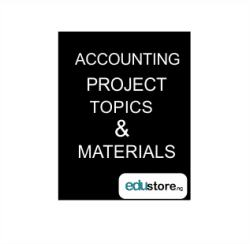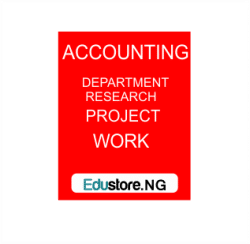This study investigates the relationship that exists between corporate governance and firm
performance of some selected companies listed on the Nigerian Stock Exchange. The intent of
the study is to determine whether corporate governance mechanisms- CEO duality, board size
audit committee independence, and ownership concentration have an impact on firm performance surrogated by return on assets (ROA); return on equity (ROE), profit margin (PM).
It provides empirical evidence for fifty two (52) non-financial firms in Nigeria for a period of
2003 to 2008. The Generalised Least Square (GLS) regression is employed to examine the
relationship existing between the variables. The results reveal that board size, audit committee
independence, ownership concentration have a significant relationship with return on equity and
profit margin. It is also observed that CEO duality has no impact on firm performance. The
advocacy is for the Securities and Exchange Commission to take into cognisance industry
specific effects before formulating codes of corporate governance that determine the characteristic of the audit committee or the board structure. Proposition is also made for the
Corporate Governance Committee of companies to endeavour to do a regular appraisal of their
corporate governance compliance status so as to understand its effect on performance.
Keywords: Corporate Governance, Firm performance, Agency Theory, Agency Costs
Certification—————————————————————-..iii
Declaration——————————————————–………………..iv
Dedication —————————————————————-….v
Acknowledgment————————————————.———-…..vi
Abstract————————————————.————.——..vii
Table of Contents————————————————————..ix
List of Figures ————————————————————–.xiv
List of Table ————————————————————–….xv
Chapter One: Introduction—————————————-.——–..–.1
1.0 Background to the study———————————————-…..1
1.1 Statement of Problem————————————————–..2
1.2 Objectives of Study—————————————————-.3
1.3 Research Questions————————————————–……4
1.4 Hypotheses———————————————————-…4
1.5 Scope of Study——————————————————–.4
1.6 Significance of Study————————————————–…5
1.7 Limitations of Study—————————————————-.6
1.8 Methodology———————————————————-6
1.9 Definition of Terms————————————————–……7
Chapter Two: Literature Review—————————————-.–.—-.9
2.1 Introduction ——————————————————–.–.9
2.2 Conceptual Framework————————————————….10
2.2.1 Agency Concept—————————————————-……10
2.2.2 Corporate Governance Mechanisms for Reducing Agency Costs—————-..14
2.2.2.1 Board Size———————————————————-…14
2.2.2.2 CEO Duality——————————————————–….15
2.2.2.2 Ownership Concentration————————————————17
2.2.2.3 Audit Committee Independence——————————————..18
2.2.3 Summary of Theory, Hypothesis and Conceptual Model———————-….19
2.3 Theoretical Framework of Corporate Governance—————————-….21
2.3.1 Stakeholder Theory—————————————————-…22
2.3.2 Stewardship theory—————————————————-…22
2.3.3 Resource Dependency Theory (RDT)————————————……22
2.3.4 Agency theory——————————————————–…23
2.3.5 Assumptions of Agency Theory——————————————….24
2.3.6 Limitations of Agency Theory——————————————–..25
2.4. Measuring Firm Performance——————————————–….26
2.5 Measuring Control Variables——————————————–.–28
2.5.1 Company Size———————————————————-29
2.5.2 Leverage————————————————————…..28
2.6 Corporate Governance and Performance Measures—————————-…29
2.7 Methodological Review————————————————–.31
2.8 Corporate Governance Measures in Nigeria———————————-..32
2.8.1 The Role of the Board of Directors, Chairman, and Chief Executive Officer——–..32
2.8.2 The Role of the Audit Committee——————————————..33
Chapter Three: Research Methodology —————-.——————..——.34
3.1 Introduction————————————————————34
3.2 Research Design——————————————————–.34
3.3 Population of Study—————————————————-…34
3.4 Sample size and Sampling Technique————————————..–.34
3.5 Data Gathering Method————————————————–..35
3.5.1 Sources of Data——————————————————–. 35
3.5.2 Instruments of Data Collection—————————————-..—-35
3.5.3 Validity and Reliability of Instruments————————————–.35
3.6 Data Analysis Method————————————————–…36
3.6.1 Methods of Data Analysis————————————————.36
3.6.2 Instruments for Data Analysis (Including formulae) —————————-36
3.6.3 Model Specification—————————————————-…37
Chapter Four: Data Presentation and Analysis ——————–..——–.—-.. 39
4.1 Introduction———————————————————-..39
4.2 Data Presentation——————————————————..39
4.2.1 Industry Based Presentation———————————————-.39
4.3 Data Analysis ——————————————————–….41
4.3.1 Summary Statistics——————————————————41
4.3.2 Correlation Analysis—————————————————-..46
4.3.3 Econometric Analysis—————————————————-47
Chapter Five: Summary, Findings, Conclusion And Recommendations————–..52
5.1 Introduction———————————————————-..52
5.2 Summary of Work Done————————————————…52
5.3 Findings————————————————————–.53
5.3.1 Theoretical Findings—————————————————-..53
5.3.2 Empirical Findings——————————————————.54
5.4 Conclusion ——————————————————–…–.55
5.5 Recommendations——————————–..———————-55
5.6 Suggestions for Further Studies—————————————-………56
References —-…——————————————————.58
Appendices ————————————————————–…–66
Appendix 1 Sample Companies and Their Industries———————-.–66
Appendix 11 Generalised Least Square Regression Result Of Estimated Model (Fixed
Effects) ————————————————–68
- For Reference Only: Materials are for research, citation, and idea generation purposes and not for submission as your original final year project work.
- Avoid Plagiarism: Do not copy or submit this content as your own project. Doing so may result in academic consequences.
- Use as a Framework: This complete project research material should guide the development of your own final year project work.
- Academic Access: This platform is designed to reduce the stress of visiting school libraries by providing easy access to research materials.
- Institutional Support: Tertiary institutions encourage the review of previous academic works such as journals and theses.
- Open Education: The site is maintained through paid subscriptions to continue offering open access educational resources.






